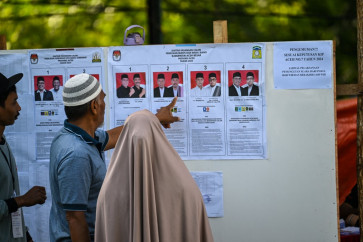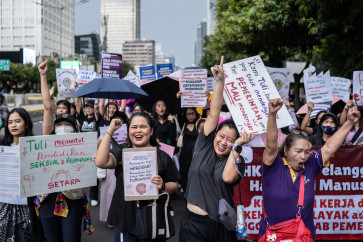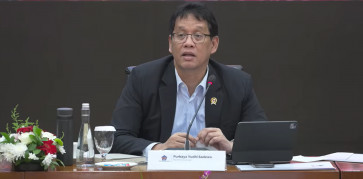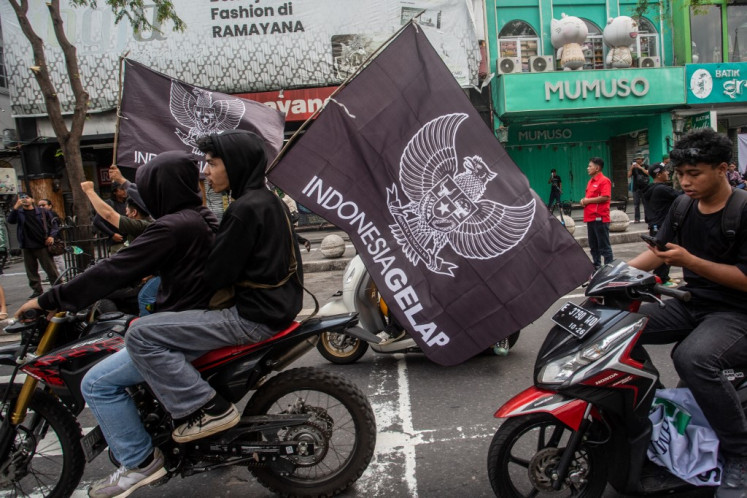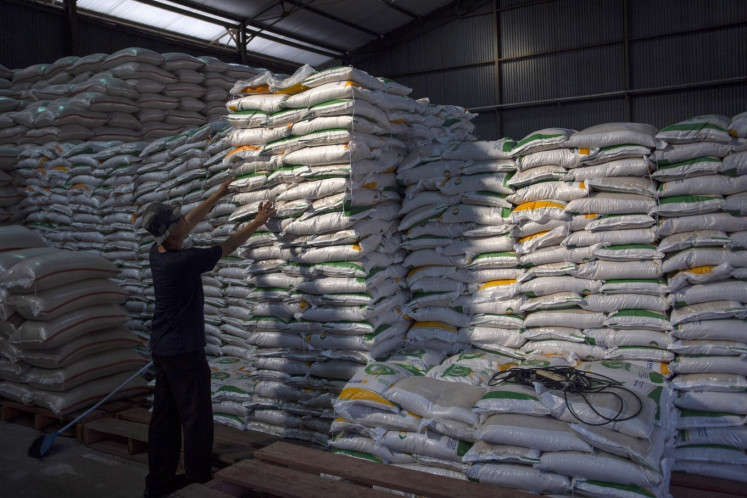Popular Reads
Top Results
Can't find what you're looking for?
View all search resultsPopular Reads
Top Results
Can't find what you're looking for?
View all search resultsDiabetes, the silent killer
Alerted: Physician Steven Russell remotely checks the glucose levels of a study subject in real time from his car in Massachusetts
Change text size
Gift Premium Articles
to Anyone
A
span class="caption" style="width: 498px;">Alerted: Physician Steven Russell remotely checks the glucose levels of a study subject in real time from his car in Massachusetts. (Reuters/Bryan Snyder)
Food has been and always will be at the heart of the Indonesian lifestyle.
From the creamy texture of slow cooked beef in coconut milk to the world-famous nasi goreng, food is the spice of life for most Indonesians.
Sadly, there is mounting evidence that the same thing Indonesians hold so dear to their hearts is also costing them their health.
In 2013, 8.5 million Indonesians suffered from diabetes according to the International Diabetes Federation, up from 7.6 million in 2012. Of these, over 90 percent have Type 2 diabetes, otherwise known as Adult Onset Diabetes.
So what is Type 2 diabetes?
'Adult Onset Diabetes is basically caused by unhealthy lifestyle, poor diet and insufficient exercise,' said Ervin Tampubolon, a physician at Klinik Diabetes Nusantara.
Ervin and his colleague, Rielya Pantouw, provide regular consultations for diabetics, prescribe the necessary medication for them and ensure that their blood sugar levels remain stable.
'In Type 2 Diabetes, an excess of free fatty acids reduce the effectiveness of the insulin produced by the pancreas by causing cells to become insulin resistant. This result is dangerous build-up of glucose in the blood stream,' explained Rielya.
'A newly diagnosed diabetic who has been put on a regular dose of Amaryl, a common blood-sugar lowering drug, would spend around Rp 400,000 a month on medication,' Ervin says.
In 2014 alone, the medical cost of treating diabetes is expected to cost the Indonesian government between Rp 5 trillion (US$441 million) to Rp 8 trillion.
The amount does not take into account the cost of dealing with diseases that often co-occur with diabetes.
'Uncontrolled diabetes in the long term will cause damage to nerves and blood vessels, increasing the risk of coronary heart disease, heart attacks and stroke to name a few,' says Rielya, who is also a physician at Klinik Diabetes Nusantara.
Furthermore, the proportion of the Indonesian population with diabetes is consistently on the rise.
A study published by the University of Indonesia's School of Medicine in cooperation with the London School of Economics found that the prevalence of diabetes in Jakarta rose from 1.7 percent in 1982 to 5.7 percent in 1993, and then more than doubled to 12.8 percent in 2001.
In the future, the population of Indonesian diabetics is expected to grow annually at a rate of 6 percent, higher than the national population growth rate, according to a report conducted by global health care subsidiary PT Novo Nordisk Indonesia, in cooperation with the Health Ministry.
Given the rapid growth of Indonesia's diabetic population, medical costs can only be expected to increase further in the future. This begs the question, should we continue to focus exclusively on medication, or is it time to focus on prevention?
While physicians in Indonesia prescribe diabetes medication to stabilize their patients' disease, across the Pacific Ocean, in a small New Jersey office, one physician and his medical team dedicate their time to reversing Type 2 Diabetes.
Joel Fuhrman ' a family business executive turned medical doctor ' enjoys a strong track record of helping critical patients achieve a life free of diabetes.
His technique boasts no magic potions or pills. Instead, it follows a simple diet plan of removing high calorie foods with low nutritional value that are high in trans-fats and animal based protein, and replacing them with low calorie, nutritious and plant-based foods. Hence the name Nutritarian Diet.
'The diet I recommend is very high in fibre and has a low glycemic index, which helps to keep blood sugar levels at a normal, healthy range,' says Fuhrman, who wrote The End of Diabetes.
In a world where most physicians follow the standard practise of analysing food groups to meet the necessary protein, carbohydrate and fat requirements of their diabetic patients, Fuhrman focuses instead on meeting the nutritional requirements of his patients by designing their diet based on low-starch vegetables.
The key to Fuhrman's vegetable-based lifestyle lies in one critical component: phytochemicals, a micronutrient that enables the body to detoxify metabolic waste, repair oxidative cell damage and protect against cancerous cells.
'There are tens of thousands of phytochemicals found in vegetable based foods. Vegetables, beans, berries and seeds are particularly high in these nutrients,' says Fuhrman.
A typical day for followers of the Nutritarian Diet generally comprises of two main meals a day consisting of raw and cooked vegetables with a cup of beans, and a light breakfast that incorporates berries. As an added bonus, the high fibre content of these foods creates the sensation of being full and reduces the urge to over eat.
The results speak for themselves. The typical results for a Type 2 Diabetes patient who follows this diet is a 50 percent reduction in medication consumption in the first week, more in the first month, and typically 100 percent within six months.
More importantly, 'The need to take insulin is eliminated within the first week,' says Fuhrman.
How possible is it to follow the Nutritarian Diet in Jakarta, considering the stressful lifestyle of most Jakartans, which includes combating hours of traffic and working long hours, leading most people to choose pre-prepared, high-carb processed foods with little or no nutritional value.
With the challenges in mind, wouldn't a Nutritarian Diet be expensive and impractical?
'Lentils, beans, cabbage, carrots and beets are not expensive to purchase or grow,' replies Fuhrman.
'Low-nutrient processed foods not only increase the chances of getting diabetes, but are cancer causing and addictive. What will happen is that the medical costs will skyrocket and the population will be spending more on medical care and less on food.'
Ironically, this already seems to be the case in Indonesia. A Nutritarian Diet requires slightly more preparation than walking down the street at lunch time with your wallet.
Tips
Lifestyle changes are tedious and difficult to make. However, a small change in lifestyle could provide Indonesians with a far healthier and more fulfilling life. On a wider scale, it could change the fate of a nation.
Here are a few tips offered in Fuhrman's book The End of Diabetes that make this lifestyle change easier to follow:
'¢ Buy large amounts of vegetables, cook large helpings on the weekend, separate the dish into individual portions and take one container to work a day.
'¢ Buy local vegetables such as cauliflower, spinach, string beans and kidney beans.
'¢ For those concerned about pesticide residue, wash vegetables using a rubber lined glove in hot water.
'¢ Avoid oil. Rather than stir-frying, try water-sautéing. Place a pan on high heat, place two to three table spoons of water, wait till it sizzles, add vegetables in it, stirring and then covering to maintain moisture. When water is completely absorbed, place another two tablespoons of water and continue until all the vegetables are lightly cooked. This results in deliciously cooked vegetables.
'¢ When craving rice, buy black rice. It's lighter on the wallet and much more nutritious than white rice.
'¢ Eliminate white rice, white bread and white pasta, all of which are highly refined foods that will send blood sugar to elevated levels with almost no nutritional benefits.


